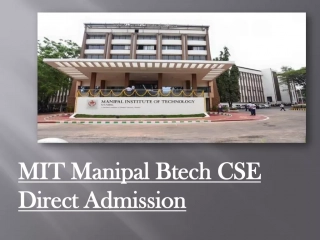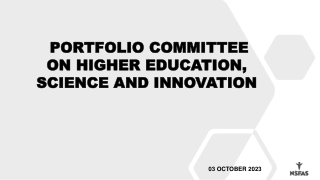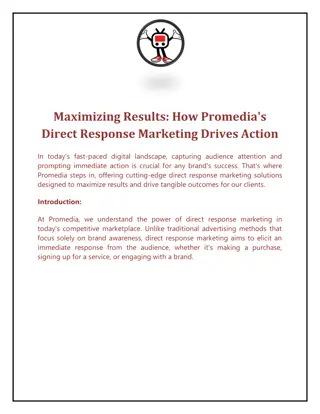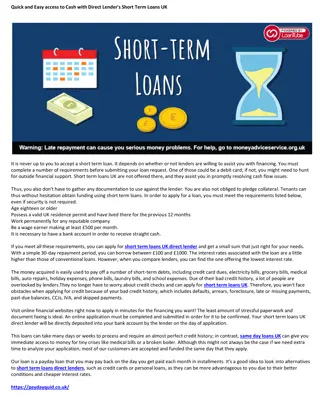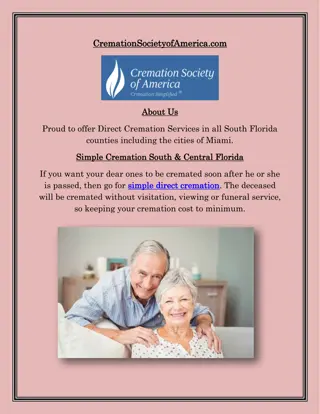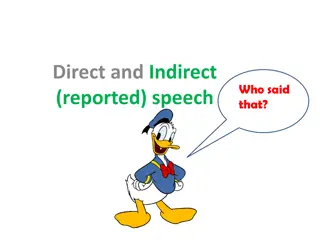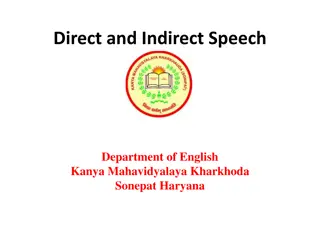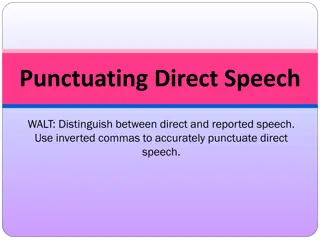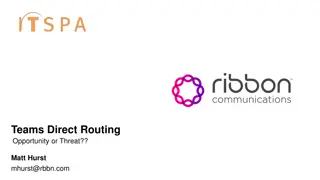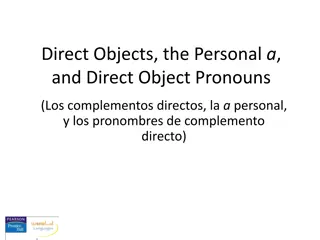Project DIRECT
This seminar covers social partner views on direct participation, focusing on the Toyota Way and its potential transferability to hospitals. It explores deep forms of direct participation and their interaction with union interests.
Download Presentation

Please find below an Image/Link to download the presentation.
The content on the website is provided AS IS for your information and personal use only. It may not be sold, licensed, or shared on other websites without obtaining consent from the author.If you encounter any issues during the download, it is possible that the publisher has removed the file from their server.
You are allowed to download the files provided on this website for personal or commercial use, subject to the condition that they are used lawfully. All files are the property of their respective owners.
The content on the website is provided AS IS for your information and personal use only. It may not be sold, licensed, or shared on other websites without obtaining consent from the author.
E N D
Presentation Transcript
Project DIRECT JOINT IRISH / UK SEMINAR Wellington Park Hotel, Malone Road, Belfast, BT9 6RU 5 and 6 March 2018 Michael Gold and Chris Rees
What this presentation covers Presentation based on interim results from project Overview of social partner views on direct participation Toyota: outline of direct participation (the Toyota Way ) Leeds Teaching Hospitals NHS Trust (the Leeds Way ) Contrasts and comparisons: to what extent can the Toyota Way be transferred to hospitals and embedded into them?
General summary of social partner views DP is restricted to operational, not strategic, issues DP generally introduced at management initiative, hence seen as a management tool (e.g. communications, employee surveys, team briefings) Skills and resources required to make DP work, so it s not just a form of PR TUs accept DP as part of management function, but seek to adapt it to their own agenda, e.g. to enhance skills (through union learning reps and learning agreements) DP seen by TUs to work best alongside TU representation and collective bargaining DP may also be delegative, and so potentially transformative - hence surface forms of DP co-exist alongside deeper forms This presentation focuses on these deeper forms and their durability, and how they interact with union interests.
Toyota Toyota Motor Manufacturing (UK) opened 1992: Burnaston (Derby): car manufacturing/ assembly (2,500 workers or members ) Deeside: engine manufacturing (500 members) Hence 3,000 members in total: 90% production, 10% office/ support The two sites operate as one plant Single status employment, one union (Unite)
Employee representation Toyota Members Advisory Board (TMAB), covers both sites Agenda: all company issues, information, consultation, negotiation of annual pay round, H&S, dispute resolution 12 members plus full-time convenor Unite single union (55% density overall) Since 2014, all members of TMAB must be Unite, and only Unite members may be represented by Unite
The Toyota Way: Communications Directors staged events Communications time built into each shift Cascade briefings through teams/ sections/ groups: ten-ten briefs (10 minutes at 10.00) Notice boards, videos in plant entrances Communication is king We spend all our time in meetings (Unite FT Convenor)
The Toyota Way: Continuous improvement Kaizen continuous improvement Covers quality, costs, environment, H&S etc. Operates at all levels: teams/ sections/ groups Expectation of two kaizen per member per month feeds into appraisal system H&S kaizen two Mondays a month, teams evaluate a work process Quality circles a tool to promote problem-solving skills One or two a year in each shop Area selected for problem-solving Greater detail than kaizen, and teams are involved
Hence multi-skilling Lean production versatility essential Single grading system no occupational categories other than member, team leader, group leader and section leader Each member proficient in at least two processes (assembly, paint, welding etc.) Processes themselves largely designed/ shaped by members We don t know anything different ; Kaizen becomes second nature (Unite FT Convenor)
Work intensification? Toyota Way: long-term stable employment Kaizen won t work if it threatens jobs (HR Manager) Intention is to remove job content to reduce burden on workers Line speed is determined by customer demand what changes is the number of processes required to build a car (e.g. reduction from 100 to 75 over the course of a production cycle) But: source of conflict is contracted overtime Maximum two hours overtime may be expected on the day, 90 minutes notice You never quite know when you re going home (Unite FT Convenor)
Reasons for success Greenfield site ( We don t know anything different ) Recruitment process: - Number of applications - Blue Arrow (agency) used for numerical flexibility and as an employment filter (10% members) Internal labour market - But: turnover of members: 2%, turnover of agency staff: 20% Management continuity Competitive pay and conditions Guaranteed no redundancies/ work intensification
Does the Toyota Way transfer to the health service? Mid Staffs Hospital crisis (2005-09) Francis Inquiry Report (February 2013) A disputed estimate suggested that between 400 and 1,200 patients died as a result of poor care over the 50 months between January 2005 and March 2009 at Stafford hospital, a small district general hospital in Staffordshire. It is commonly known as the Mid Staffs scandal because Stafford hospital was and is run by the Mid Staffordshire NHS hospital trust, which in 2008 acquired foundation trust status, making it semi-independent of Department of Health control. Decision-making and especially cost-cutting as part of its pursuit of that status was later cited as a key reason why poor care took hold and was allowed to persist for so long. (Guardian, 6 February 2013)
Ways forward NHS made 12.5 m available to five NHS Trusts to buy into the training methods advocated by the Virginia Mason Institute (healthcare institute) Leeds Teaching Hospitals NHS Trust was one of the five successful bidders Basic principle: place the patient first
The Leeds Way The Leeds Improvement Method championed by Trust Chair, Linda Pollard (appointed Feb 2013), and CEO, Julian Hartley (appointed Oct 2013) Crowdsourcing of all 17,000 employees to establish our values (5,000 contributed): Patient-centred Fair Accountable Collaborative Empowered Toyota-style management integrated into all Leeds NHS Trust procedures, including kaizen, from porters to professors
The Leeds Improvement Method Weekly induction carried out personally by CEO (50-100 new staff every week) Town hall type meetings Kaizen Rapid improvement weeks: intense discussions on how to reduce waste (e.g. patient records, reception areas) Safety huddles Staff recognised for good ideas, but no expectations about numbers of kaizen to be proposed
Staff-side reactions Respect for staff embedded in system to prevent work intensification (which would be challenged by the unions) No redundancies result from improvements Focus on waste reduction and improvements, not cost- cutting Chair of Staff Council involved from start to keep everything open (Staff Council represents 14 staff-side organisations, including Unite, Unison and GMB, as well as RCN, RCM etc.)
Results. Staff surveys over 12 years linear data, same questions Between 5,000 and 7,000 returns out of 17,000 staff 2012: 18 questions in bottom 20%, one in top 20% 2017: one question in bottom 20%, 13 in top 20% N.B. - Only 2.4% payroll spent on agency staff Very little outsourcing patient catering, cleaning, security, estates/ facilities all in-house.
Toyota/ Leeds NHS Trust comparisons (1) How embedded is the Leeds Way ? Brownfield v. greenfield sites Continuity of management at Toyota (personnel and style) Recruitment members at Toyota a blank slate , single status, very few occupational categories, integrated production Stable employment agency used as a buffer to protect core
Toyota/ Leeds NHS Trust comparisons (2) Political nature of NHS, Mid Staffs crisis led to re-think (Cf. MRSA deaths led to rethink over outsourcing hospital cleaning services) Leeds NHS Trust bought into the Virginia Mason method following competitive bidding process Leeds Way led by champions from the top: future change of management or priorities could change things back? what if Julian Hartley were to leave? Recruitment Leeds, many levels, many occupations, higher turnover, some categories recruited by the university (e.g. student nurses)
Conclusions Durability of direct participation at its most transformative many factors involved, e.g. Greenfield/ brownfield site? Continuity of management? Dependence on champions? Control over recruitment? Nature of local labour markets? Nature of the work itself? (Hospitals are far more complex than car plants!) And, of course, role of unions?
Summary of interviews Stage two: eight interviewees, five social partner organisations IPA Patrick Bri ne, Derek Luckhurst (12 September 2017) CIPD Ramya Yarlagadda (14 September 2017) Unite the Union Tony Burke, Ben Richards (22 September 2017) TUC Matthew Creagh, Iain Murray (18 December 2017) Workplace Innovation Ltd/ Workplace Innovation Europe Peter Totterdill (10 January 2018) (CBI declined, 17 August 2017)
Summary of interviews Stage three: eight interviewees, two organisations (manufacturing/ hospital) Toyota Motor Manufacturing UK: Peter Tsouvallaris, full-time senior representative, Unite (21 Feb 2018) Tom Sawyer, Unite, East Midlands Regional Officer (21 Feb 2018) Dan Janes, section manager, Human Resources (21 Feb 2018) Leeds Teaching Hospitals NHS Trust (St James s University Hospital, Leeds): Dean Royles, Director of HR and Organisational Development (27 Feb 2018) Joe Cohen, Chair of Staff Council (27 Feb 2018) Karen Vella, Deputy Director of HR Organisational Development (27 Feb 2018) Wyn Jones, Deputy Director of HR Resourcing and Workforce Systems (28 Feb 2018) Julie Sutcliffe, Head of Medical Workforce (28 Feb 2018)
Partner Trusts (Virginia Mason methods) University Hospitals Coventry and Warwickshire NHS Trust Shrewsbury and Telford Hospital NHS Trust Barking, Havering and Redbridge University Hospitals NHS Trust Leeds Teaching Hospitals NHS Trust Surrey and Sussex Healthcare NHS Trust
Leeds Teaching Hospitals NHS Trust staff profiles: 11,604 Full Time employees (65.42%) 5,815 Part Time employees (32.78%) Of which 2,985 Fixed Term Contracts (16.82%) ** Full Time Fixed Term Contracts will also have been counted as a Full Time Employee 803 Zero Hours contacts including Bank (4.52%) ** This includes any honorary contracts where the fte is 0 and potentially substantive staff who also have a separate bank contract but not staff bank contracts. We currently have 1,655 people on our nurse bank - both registered and unregistered staff, 343 Honorary contracts (1.93%) ** FTE can be > 0 452 Volunteers - volunteers are not classed as trust employees





